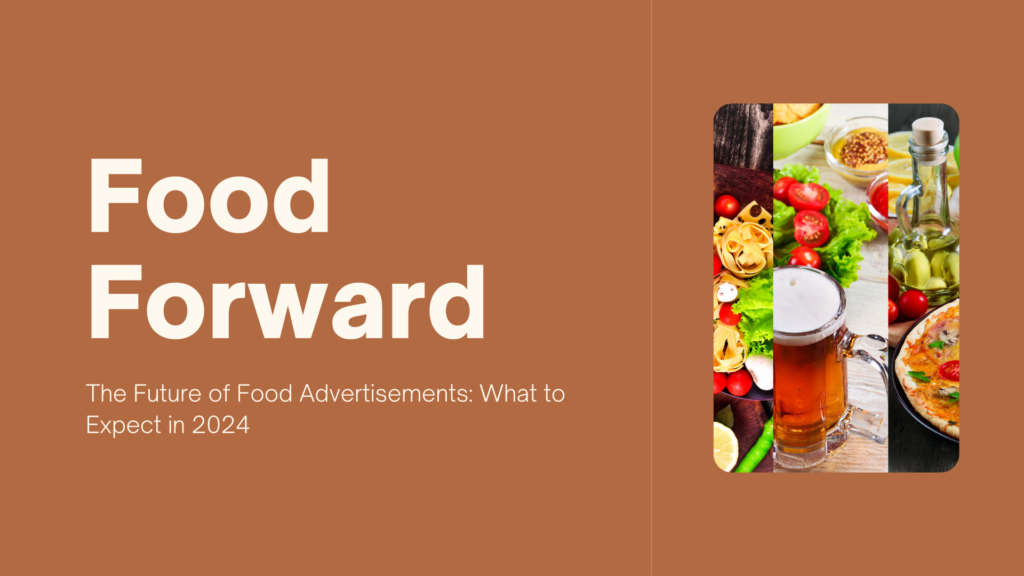Introduction to food advertising today
Food ads are enticing, and every taste tells a narrative. As we examine culinary marketing, one thing becomes clear: technology is changing our future and adding inventiveness. Join us on this culinary trip as we study food ads and share tasty predictions for 2024. Let’s taste everything from targeted advertisements to virtual feasts and learn how firms can remain ahead in this ever-changing marketing menu.

Technology’s impact on food ads
Technological advances are changing food advertising. As data analytics improve, corporations can target advertising to the appropriate audience at the right moment. Businesses may personalize ads by analyzing customer behavior and preferences with AI and machine learning technologies.
Consumers may virtually engage with food goods before buying them using virtual and augmented reality. This interactive strategy boosts engagement and gives businesses a unique platform.
Food advertising relies on social media, with influencer marketing growing. Brands can reach more people and promote items authentically by working with influencers.
As technology advances, food ads will become more creative to attract customers and boost sales. Technological advances will affect food advertising in the future.
Personalised advertisements using consumer data
As 2024 begins, food ads are changing dramatically. Personalization and targeting based on customer data are a major trend.
Technology and data analytics allow corporations to customize advertising to individual interests and habits. Imagine receiving an ad for your favorite food when you’re hungry—that’s customized marketing.
Consumer data like purchase history, internet behavior, and demographics may help marketers design hyper-targeted ads that connect with their audience. This boosts ad performance and client satisfaction.
More advanced algorithms and AI-driven technology will shape food product advertising in the future years. It’s a revolutionary period for marketers seeking deeper audience connections.
Food sector influencer marketing’s growth
Influencer marketing has transformed food product promotion in the digital era. Social media influencers with large followings can impact consumer purchases. Food ads may be real and engaging by working with influencers that share a brand’s values and target demographic.
Food goods are more tempting to customers when portrayed by these influencers in a realistic and appealing way. Influencers personalize food ads with delicious recipe videos and honest restaurant ratings.
In 2024, influencer marketing will continue to shape food advertising. Companies who embrace this trend and work with influencers will have an advantage in a congested market.
Food product VR/AR experiences
Imagine entering a virtual world where you can see, smell, and taste your favorite foods from home. AR and VR are changing how we view food ads.
As VR headsets and AR applications become more available, customers may now engage with food goods in new ways. The options are infinite, from exploring virtual farms for supplies to making their own recipes.
Immersive technologies engage people and empower companies to present their products in new and engaging ways. VR and AR are changing food promotion by providing a 360-degree view of a restaurant kitchen and virtual menu samples.
Food advertising ethics
Consumers and authorities are concerned about ethics in food ads’ ever-changing scene. Advertisements can blend truth and exaggeration due to their persuasive power.
Promoting harmful or deceptive food to vulnerable groups, especially children, is a serious problem. Ethics concerns arise when ads promote sugary foods or fast meals without noting their health risks.
Food industry sustainability concerns are developing. Verify that organic or eco-friendly product ads are not greenwashing to entice eco-conscious customers.
Ethical food advertising requires transparency. Consumers demand accurate information about food origin, production, and nutritional value.
As we approach 2024, companies must address these ethical issues to gain trust and traverse a more demanding customer base.
Food ad predictions for 2024
By 2024, food ads will be increasingly tailored and immersive due to significant technological and consumer behavior changes. Data analytics will help brands target customers with advertising that match their tastes and actions.
Influencer marketing will continue to shape food product promotion since influencers reach target consumers authentically. These agreements will foster brand-consumer relationships and loyalty.
Virtual and augmented reality will become more popular in food advertising, letting people engage with items in new ways. This immersive strategy improves user experience and conversion rates.
As restrictions tighten around deceptive or manipulative advertising, ethical considerations about transparency may also arise. Businesses must stress authenticity and honesty in their campaigns while staying ahead of technology-driven advertising trends to adapt to these developments.
How firms may adjust and stay ahead after these developments
Businesses must remain ahead of food advertising trends to succeed. Using technology to analyze customer data and develop targeted marketing is one approach to adapt. Understanding their tastes and actions helps organizations adjust marketing techniques.
Working with culinary influencers boosts brand awareness and trust. Influencers who share your brand values can increase brand awareness and customer trust. Using virtual and augmented reality for food goods may also differentiate firms.
Food advertising ethics must be addressed to ensure openness and customer confidence. Businesses may build consumer relationships by presenting their products well. In 2024, food advertising enterprises must innovate while maintaining ethics to succeed.
Conclusion
Future food ads in 2024 will be vibrant and inventive. Businesses must adapt to be relevant as technology personalizes, influencer marketing shapes customer preferences, and virtual experiences enhance product engagement. Companies may reach their target demographic and establish effective advertising campaigns by embracing these changes and staying ahead of the curve. In the next years, food ads will continue to change, giving great chances for businesses ready to innovate and interact with their audience in new and innovative ways.
